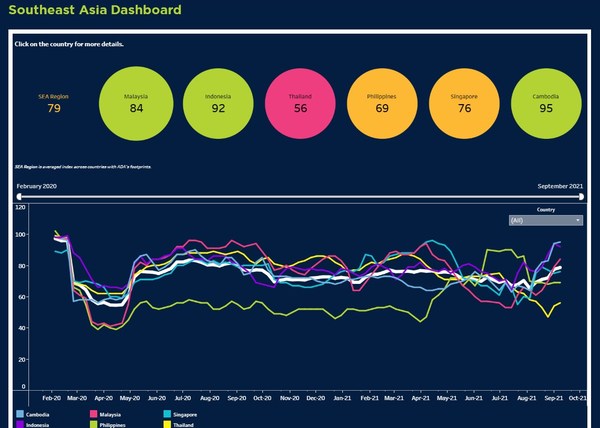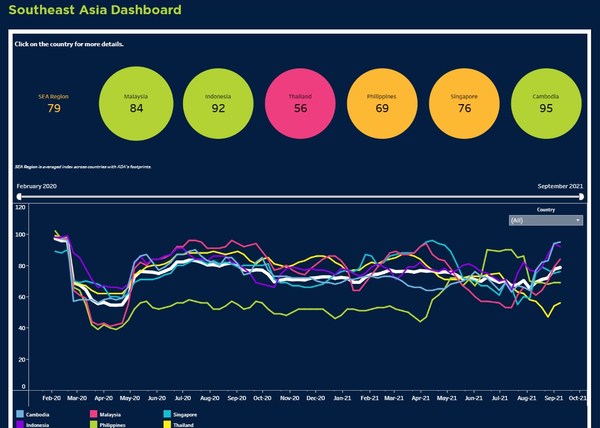 |
- Dashboard provides data-driven insights on how consumer behaviour, mobility, and digital consumption are evolving due to COVID-19
- Index combines online and offline trackers to give businesses on-the-ground visibility at the national and state level
- Cambodia, Indonesia, and Malaysia are currently leading the pack in business recovery amid a huge divergence across Southeast Asia
SINGAPORE, Sept. 29, 2021 /PRNewswire/ — ADA has launched a new dashboard that offers data-driven insights for businesses in Southeast Asia as they navigate major disruptions to consumer behaviour caused by the COVID-19 pandemic.
Leveraging on ADA’s in-house data management platform, XACT, the Recovery Index was built with anonymised data sourced from millions of mobile devices and apps. While not a traditional economic indicator, businesses can use the dashboard to guide their decision-making by observing consumers’ mobility and digital consumption in near real-time.
Users of the dashboard, which is free to access, can drill down from the regional view to the national and state-level in eight countries, namely Singapore, Malaysia, Indonesia, Thailand, Philippines, Cambodia, Sri Lanka, and Bangladesh.
Some notable insights from the dashboard (as of September 22) include:
- Indonesia and Cambodia are around 90% back to normal having rebounded strongly from a low point in August caused by the Delta variant.
- Bangladesh has exceeded its pre-pandemic normal, while Indonesia and Cambodia are next in line to reach the "old normal".
- Thailand, which was relatively unscathed by COVID-19 last year, lost its early gains and is now the furthest from normal in Southeast Asia. Mobility in most regions has dropped to 50% of pre-pandemic levels with only Rayong, Songkhla and some areas around Bangkok bucking the trend.
- In Indonesia, mobility has recovered more quickly in Java where Jakarta is located compared to surrounding islands. Footfall at F&B outlets has climbed to 110% of pre-COVID levels while footfall at malls has fully recovered. Usage of business and productivity apps, however, has collapsed to 60% of pre-COVID levels, even as usage of fitness apps has surged to 140%.
- In Malaysia, the main economic hub of Klang Valley is leading the recovery vis-a-vis other corridors in the Peninsula and the Bornean states. The recent easing of lockdown measures has seen footfall in malls jump to 130% of pre-COVID levels, even as road density and other mobility indicators are yet to fully recover.
- In the Philippines, footfall at malls and F&B outlets had recovered fully in June before declining to 70% of pre-COVID levels currently following a recent shift in lockdown policies in Manila.
Srinivas Gattamneni, Chief Executive Officer of ADA, said: "The COVID-19 pandemic has caused, and is still causing, major disruptions to consumers affecting how they shop, where they go, and what they do on a daily basis. We created this dashboard as a resource for businesses to make sense of and respond to the ‘new normal’ in consumer behaviour. The dashboard can serve as a guide to what has changed pre- and post-pandemic in terms of shopping, app usage, and mobility, allowing marketers to pivot their customer acquisition and retention strategies in an environment that continues to be volatile."
Visit https://ada-asia.com/adas-recovery-index-covid-dashboard to find out more.
About ADA
ADA is a data and artificial intelligence company that designs and executes integrated digital, analytics, marketing, and eCommerce solutions.
Operating across 10 markets in South and Southeast Asia, ADA partners with leading brands to drive their digital and data maturity, and achieve their business goals. We are anchored on the following main services:
- Providing business insights, data enrichment, and advanced analytics
- Understanding the consumer mindset and designing data-driven creative marketing strategies
- Executing end-to-end digital marketing solutions for growth hacking, funnel optimisation, and goal optimisation
ADA complements its unique digital expertise with deep proprietary data of 375 million consumers.




